The Fantastic Warp and Weft of a Tropical Depression
2020
Lenticular prints
Dimensions variable
Courtesy of the artist
Commission by MCAD, Manila
Installation view of The Cone of Concern, Museum of Contemporary Art and Design (MCAD), Manila, Phillipines, 2020
Photo: Maculangan/ Pioneer Studios
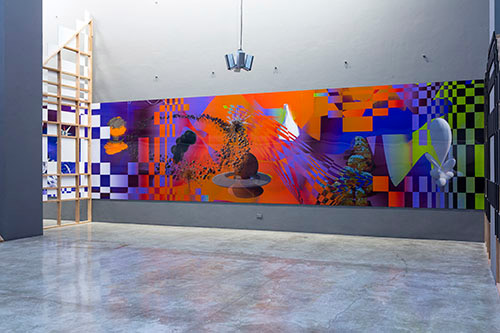

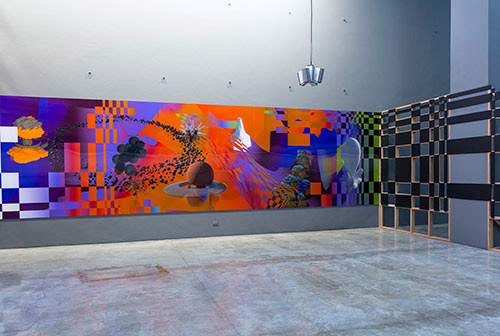

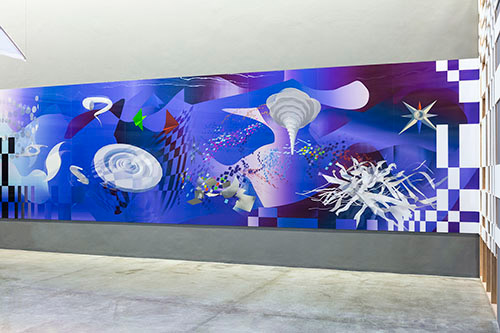


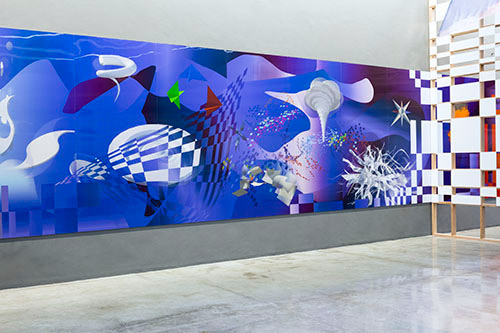



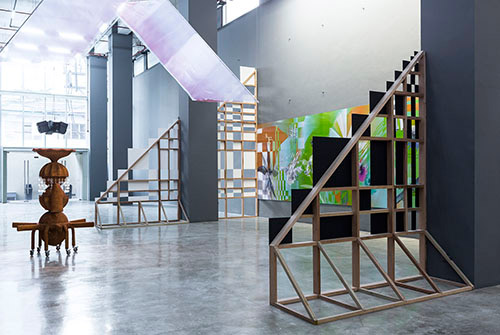

Excerpt from To Whom It May Concern: a response to Haegue Yang's exhibition The Cone of Concern in Manila. Philippines by Daisy Nam, in exhibition booklet Haegue Yang: The Cone of Concern, ed. by Joselina Cruz, Manila, 2020
The binakol patterning of Whirlwind Structures continues as a two- dimensional graphic rendering merging with the wall piece The Fantastic Warp and Weft of a Tropical Depression (2020). The wall piece is a lenticular print divided into three sections and individually installed in each of the bays. With lenticular technology, the image changes and moves when viewed from di erent angles. The Fantastic Warp and Weft of a Tropical Depression contains an amalgam of graphic illustrations with no apparent narrative or storyline. We see various renderings of objects that appear to oat through the background as if in zero gravity. These stock images were found using the key word “energy” with open-source repositories on 3D applications. Purposefully abstracted and depicted in varying scales, the print’s comic-book quality is augmented by the colorful palette that elicits whimsy. In the second bay, we spot swirls, a cyclone, the aerial view of the eye of a storm, a compass, or paper airplanes.
In the third bay, the illustrations turn darker, depicting perhaps the mushroom cloud of an atomic bomb or particles after an explosion. The binakol pattern whirls through the entirety of the wall piece. Drawing from the graphic renderings of the cone of concern used in meteorological forecasting, they compel us to imagine or to be concerned. Tropical depressions, as mentioned in the work’s title, become tropical storms when winds and air movement become stronger. At what point do tropical depressions enter our psyches? What if, instead of reacting to things with fear, we used our imagination and sense of curiosity? Could we ward o these threats with binakol patterns? With Whirlwind Structures and The Fantastic Warp and Weft of a Tropical Depression, Yang creates moments of concern through the use of binakol, a familiar pattern employed for the associative qualities that Filipino audiences would recognize. Binakol-patterned textiles were made for the home and used as blankets for ceremonial occasions in northern Philippines. Art historian David Joselit, in his recent book Heritage and Debt: Art in Globalization, writes that “the reactivation of heritage [is] a resource for inventing alternate genealogies of modernism and diverse experiences of contemporaneity.” Along these lines, Yang reshu es the hierarchy and the canon of what we know as the pinnacle of modernism. In art history, the elevated space of modernism is reserved mostly for paintings by men in the West, such as Kazimir Malevich, Piet Mondrian, and later Josef Albers. Slowly, women have entered the canon with Bridget Riley, Anni Albers, and others. Yang foregrounds the geometric patterns made by women weavers with their complex and mathematical patterning of binakol, all done on a pedal loom dating back to the 1400s in Asia, hundreds of years before what we know in the West as geometric modernism or abstraction. The hierarchy of “advanced” technologies is also challenged. Yang’s wall piece uses lenticular lenses, while the other pattern is made by the age-old weaver’s loom. Both create visuals that depict movement and convey the sensation of motion; when installed together these elements wrap the viewer in an immersive environment. The power of the materials exceeds their original forms of textiles, and is interpreted through Yang. Through her integration into her own visual language, she o ers a new reading and interpretation. Our sense of modernism widens. Our sense of what art can be widens. The cone of concern widens.
Exhibition history
The Cone of Concern, Museum of Contemporary Art and Design (MCAD), Manila, Phillipines, 2020
back to alphabetical order |
back to chronological order |